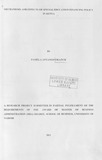| dc.description.abstract | The primary resource of every nation is the capacity of creation of its citizens. Historically, persons with disability all over the world were considered socially and physically less capable. Hence, they were not easily accepted and regarded as part and parcel of the family and community. Many persons with disability suffered neglect and rejection. The advent of education for people with disabilities (special education) is traced in United States of America began after World War II. In Kenya, Special education programmes started after independence in 1963. One of the constraints that many special schools face is the shortage of financial resource in the era of ever increasing costs on high teacher – pupil ratio requirement, transportation costs, boarding facility costs, medical facility costs and special supplies. Though Kenya government adopts the Free Primary Education program, the study on a sample of 33 special institutions find that most of the institutions depend on external financing of which the government of Kenya through the ministry of education is the largest contributor in special education financing in Kenya. The objective of the study was to determine the mechanismS and effects of financing policies in special education in kenya. A survey was undertaken; the target population was drawn from one hundred and fourty four special schools, units and secondary institution in kenya. The sample consisted of thirty three respondents selected through stratified random sampling. Primary data was collected from the head teachers of the special schools units, post secondary insitutions with the aid of questionnaires. Data pertaining to the objectives of the study was analysed using descriptive. Statistics whcih includes measures of central tendancy, measure of frequency among others. In addition, tables, pie charts and bar graphs were used.
Findings of the study show that the government of Kenya and other donors do fund special institutions according to the guideline. The policies stipulated are followed and auditing are carried out to ensure accountability of the funds. The users of funds are also inducted on the utilisation . External funding leads at 81%, documated policies on disbursement of funds was at 82% while induction on managmeent of funds were at 90.32% and finally special schools are audited with a percentage of 80.6. Though the budgetary allocation is still not adequate at 67.74% Based on findings of the study, the following recommendations were made that the Government and other donors should come up with various mechanisms through which they can establish more schools for those with disabilities to ensure they are catered for from childhood to adulthood. More teachers should be trained in order to cater for the ones with special needs. The funding organs should ensure that they start up projects that will target all the people with marginalized issues that are considered special and no one is to be left out but should also put in place proper audit and accountability structures. Institutions that can be expanded should be so that it can cater for more students with disabilities. | en |

